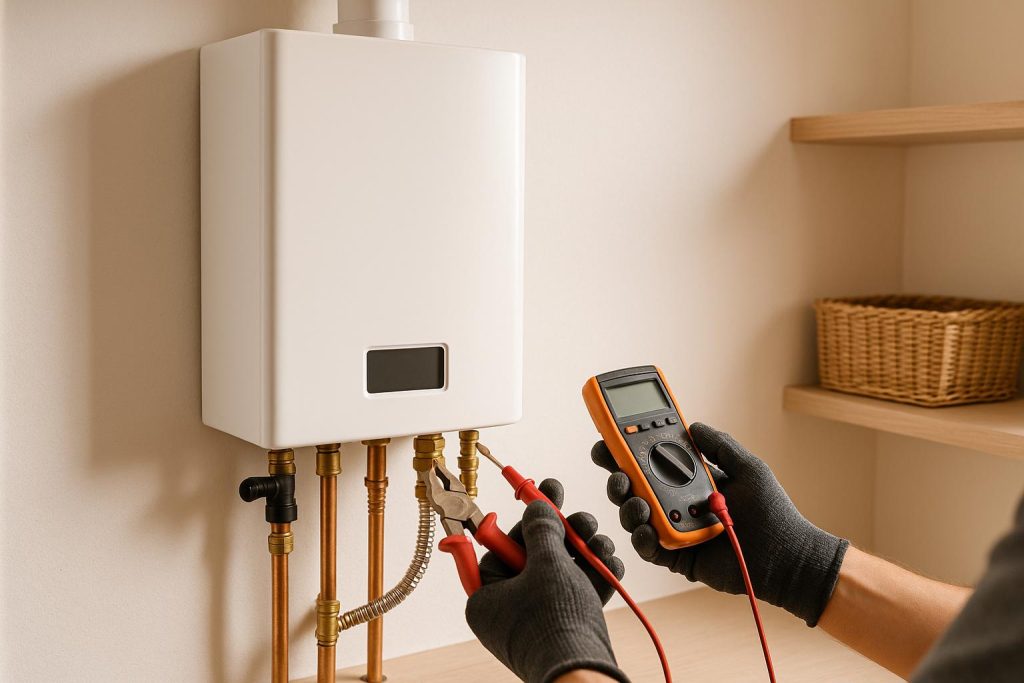Keeping a kitchen looking good goes beyond shiny counters and bright fridges; it’s also about maintaining the tools that keep everything flowing smoothly, especially your garbage disposal. Your garbage disposal is the tiny powerhouse that chops up leftovers so you can flush them away. Treat it right, and it keeps humming along; mistreat it, and you’ll face nasty clogs, stinky smells, and repair bills you’d rather avoid.
This guide walks you through the most effective garbage disposal tips to keep your kitchen cleaner, fresher, and more efficient. We’ll cover what to do, what not to do, how to clean your disposal naturally, and when it’s time to call in a professional.
Whether you’re a first-time user or just looking to prolong your unit’s lifespan, this article is packed with useful insights.
Why Garbage Disposal is Essential
Proper garbage disposal care prevents plumbing headaches and costly replacements. According to the EPA, food waste is the largest component of landfill waste in the U.S., but using your garbage disposal wisely helps reduce that. Even better? A well-maintained unit minimizes odors and supports a cleaner, more eco-friendly kitchen.
One overlooked benefit: It prevents blockages that can disrupt your entire kitchen sink system. That’s why it’s essential to know the dos and don’ts.
Quick Tips: What to Do and Not Do With Your Garbage Disposal
✅ What to Do:
- Run cold water before, during, and after use. It solidifies grease, so it grinds better.
- Cut large food pieces into smaller bits.
- Feed food gradually, not all at once.
- Use citrus peels occasionally to freshen the smell.
- Clean with ice cubes and baking soda to remove gunk and sharpen blades.
❌ What Not to Do:
- Don’t pour grease or oil into the disposal.
- Avoid fibrous items like celery or corn husks that can tangle blades.
- Never put non-food items (such as metal, glass, or plastic) down the drain.
- Skip expandable foods like pasta or rice, they swell and clog pipes.
- Avoid using harsh chemical drain cleaners they can damage seals and pipes.
For more drain care, also check out how to prevent kitchen sink clogs with simple tips.
How Garbage Disposals Work (in Simple Terms)
Your disposal isn’t a blender with sharp blades. Instead, it uses blunt impellers to spin food waste against a shredder ring, grinding it into tiny particles. Cold water assists by hardening grease and moving debris efficiently down the drain.
The result: waste gets ground and flushed through your plumbing system without causing a mess.
10 Essential Garbage Disposal Tips for Daily Use
1. Always Use Cold Water
Cold water helps fats stay solid, so they can be chopped and flushed, rather than liquefied and congealed further down the line. Hot water may seem helpful, but it causes grease to coat pipes and create clogs.
Pro Tip: Always start with cold water before turning on the disposal and let it run for at least 15 seconds after turning it off to ensure full drainage.
According to the EPA, grease buildup causes over 47% of household drain clogs annually. Cold water helps prevent this.
2. Cut Large Scraps into Smaller Bits
Smaller pieces are easier to grind. Tossing a whole chicken bone or a large fruit core into the disposal can jam or overwork the motor. Cut bulky scraps before feeding them in slowly.
Example: A whole banana peel might clog the disposal, but slicing it into 2-inch strips makes grinding more manageable.
3. Feed Items Gradually
Feeding scraps all at once can overwhelm the disposal, reduce grinding efficiency, and strain the motor. It’s best to introduce small amounts at a time to let the blades work through waste without getting stuck.
A steady trickle of waste with running water keeps everything moving smoothly and helps avoid sudden backups.
Insight: Most disposal jams occur when users overload the chamber without allowing water to carry waste through.
4. Use Citrus Peels Occasionally
Toss in lemon or orange peels once a week to freshen the disposal and mask odors. Their natural oils break down grime and leave a pleasant scent.
Quick Method: Toss in a few small peel strips and run the disposal with cold water for 20 seconds.
Bonus: Citrus oils also help dissolve minor grime buildup on the impellers and shredder ring.
5. Clean With Ice Cubes and Baking Soda
Drop a handful of ice cubes with two tablespoons of baking soda and run the disposal. The ice scrubs the blades, and baking soda neutralizes odors. Do this once a week.
Step-by-Step:
- Add 5–6 ice cubes into the disposal
- Sprinkle in 2 tablespoons of baking soda.
- Turn on the cold water and run the disposal for 30 seconds.
Fact: Weekly cleaning like this can extend the lifespan of your disposal by up to 30%.
6. Avoid Hard or Stringy Foods
Avoid fibrous veggies like celery, artichokes, and corn husks, which tend to wrap around the impellers. Similarly, bones, seeds, and pits can damage or dull blades and strain the motor.
Do Not Insert:
- Corn husks
- Onion skins
- Chicken bones
- Apple cores
Pro Tip: When in doubt, compost fibrous or dense waste instead; it’s safer and better for the environment.
7. Skip Grease and Oils
Fats and oils may seem harmless when liquid, but they harden as they cool, clinging to your pipes and accumulating over time.
Grease = Drain Disaster: A single tablespoon of bacon grease can clog multiple feet of pipe once solidified.
Kitchen Tip: After cooking, wipe greasy pans with paper towels before rinsing and disposing of the towels in the trash.
8. Don’t Use Harsh Cleaners
Avoid chemical drain cleaners, bleach, or industrial deodorizers. These substances corrode metal components and break down rubber seals, shortening your unit’s lifespan.
Natural Alternatives:
- Baking soda + vinegar = fizzing cleanse
- Ice + rock salt = physical scrub
Fact: Chemical use in disposals is also harmful to septic systems. The EPA warns that they can kill the beneficial bacteria required for breakdown.
9. Run Water Before and After Use
Initiating cold water flow before use cushions the motor startup and creates a smoother waste flush. After grinding, let the water run for 15–30 seconds to fully push particles out of the P-trap and beyond.
Pro Tip: Keep water running until you no longer hear grinding noises. This helps ensure complete disposal and drain cleaning.
10. Use It Regularly
Idle garbage disposals tend to corrode or seize up. Running the unit a few times a week, even with just water and ice, keeps parts moving and odor buildup at bay.
Habit Builder: Add “run disposal” to your cleaning checklist twice weekly to keep it in top condition.
Stat: Infrequent use leads to rusting and clogging. 40% of disposal failures are due to a lack of use or improper maintenance.
Signs It’s Time to Call a Professional
While routine care helps, sometimes you need an expert. Here’s when to call a plumber:
- Persistent foul odors despite cleaning
- The unit won’t turn on or hum without grinding
- Frequent clogs or slow drainage
- Leaks under the sink
- Strange rattling or metallic noises
Pro Tip: Regular inspections prevent small problems from becoming emergencies. Annual maintenance can save you hundreds in unexpected repair costs.
Natural Cleaning Recipe: Garbage Disposal Deodorizer
You can freshen your unit weekly with this easy mix:
- 1/2 cup baking soda
- 1 cup white vinegar
- A few ice cubes
- Citrus peel (optional)
Instructions:
- Pour baking soda, then vinegar down the drain.
- Let it sit and fizz for 10–15 minutes.
- Add ice and run the disposal with cold water.
This combo cleans the grinding chamber and neutralizes unpleasant smells without harming components.
Final Thoughts
Garbage disposals are a kitchen convenience, but only when maintained properly. With the right habits and these garbage disposal tips, you can enjoy a cleaner kitchen and fewer plumbing issues. Remember to avoid risky foods, clean them naturally, and run water before and after every use.
Stay consistent, and your disposal will last longer, perform better, and smell fresher. Most importantly, know when to call a professional before a minor issue becomes a messy disaster.
FAQs: Garbage Disposal Basics
Can I put eggshells in the garbage disposal?
No. The membrane can stick to blades, and the shell granules contribute to clogging.
What if it smells bad?
Use baking soda, vinegar, citrus peels, or ice. Avoid bleach or commercial deodorizers.
Is hot water ever okay?
Only during post-cleaning rinses when no fats or oils are involved.
How long should I run water?
At least 15 seconds before and after using the unit.
Can I use dish soap in the disposal?
Yes, it helps cut grease. A few drops of cold water while running is effective.






